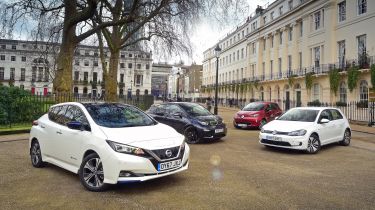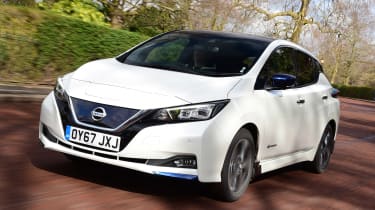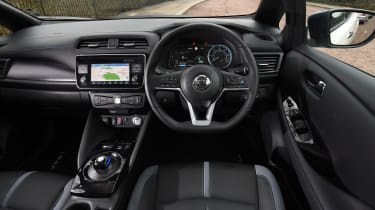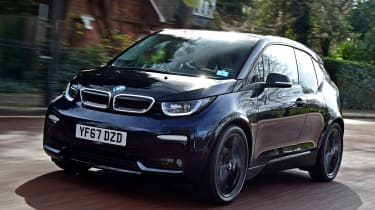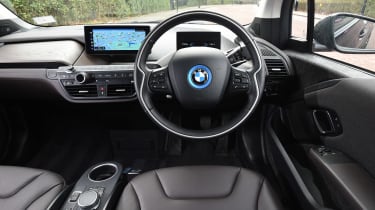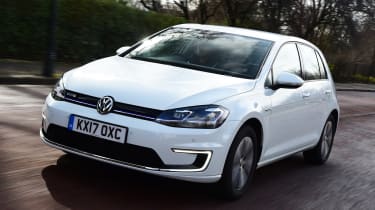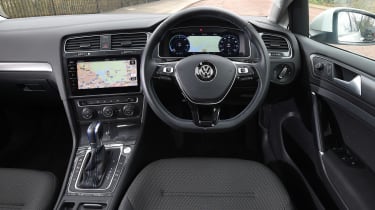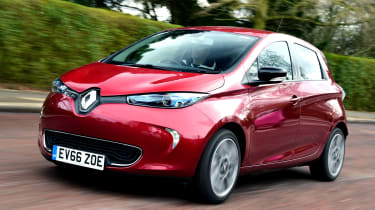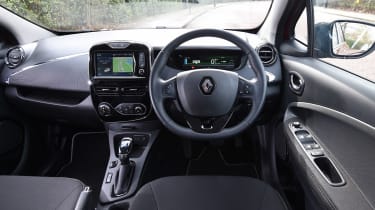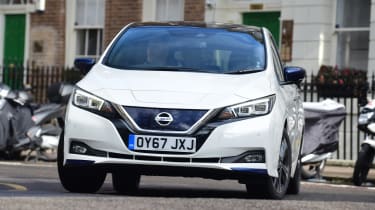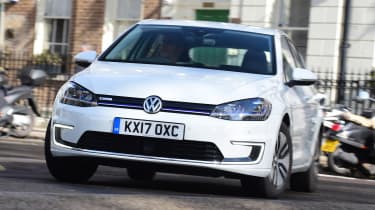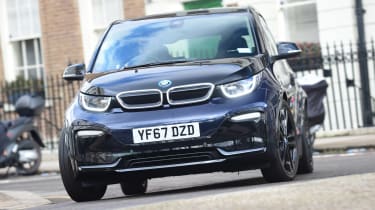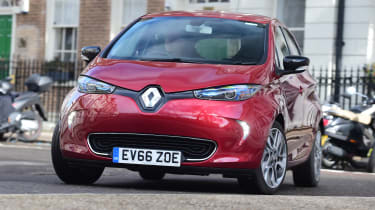Nissan Leaf vs BMW i3 vs VW e-Golf vs Renault ZOE
A lot has changed in the EV world since the first Nissan Leaf arrived. We try the Mk2 against the BMW i3, Volkswagen e-Golf and Renault ZOE
When the original Nissan Leaf appeared in 2010, it set a new standard for electric vehicles with its range and everyday usability. Now it’s time for the Leaf Mk2 to build on those abilities by offering an even longer range and the kind of driver assistance that marks the next step towards autonomous vehicles.
The original Leaf was an EV pioneer, but the second generation will have to stand out among a host of new models in the class. For this test, we put the Leaf up against three EV rivals that show how the sector has changed since the original landed in showrooms. First up is the BMW i3. Along with the i8 supercar, it’s a showcase for BMW’s cutting-edge EV tech, while a recent update boosted the car’s range and added the sportier i3s to the line-up, too.
The Volkswagen e-Golf shares the Leaf’s concept of being a compact hatch powered by electricity, and as it uses the Golf as its basis, will be a stern test for the new Nissan. Finally there’s the Renault ZOE. The EV supermini can’t match its rivals here for space, but it has been a big hit thanks to its affordability, user-friendliness and features suited to city living.
Nissan Leaf
| Model: | Nissan Leaf Tekna |
| Price: | £27,490 |
| Power: | 148bhp |
| 0-62mph: | 7.9 seconds |
| Top speed: | 89mph |
| Official range: | 217 miles |
The second-generation Nissan Leaf is aiming to bring electric motoring to the mainstream. And with the Tekna trim’s claimed range of up to 217 miles on a full charge, it can suit more lifestyles than ever. The Leaf range starts from £21,990 including the Government’s £4,500 Plug-in Car Grant, but here we test the top-spec Tekna model, which costs £27,490.
Used - available now
The Leaf delivers the kind of instant acceleration for which EVs are famous. Nissan quotes a 0-62mph time of 7.9 seconds for the Leaf, which is a second behind the i3s, but ahead of the less powerful Golf and ZOE, and the car feels sprightly enough away from the lights.
Maximum torque of 320Nm means the Nissan has plenty of mid-range power, but as with any EV, its range will plummet if you’re too eager with the accelerator. We’d recommend using the e-Pedal system instead. This adds resistance to the throttle and lets you drive using one pedal most of the time.
It’s a smooth system, and helps recoup energy to the battery without having to apply the brakes. The e-Pedal works all the way to a halt, so you soon try to drive for as long as possible without touching the brakes. It’s a great way to learn how to be a smoother, more efficient driver, and once you get into a rhythm, you’ll only ever hit the brakes in an emergency.
The rest of the Leaf driving experience is relaxing rather than exciting. A low drag coefficient means there’s not much wind noise, while road noise is well suppressed, even at higher speeds. Mounting the battery low down makes the Leaf stable in corners, while a suite of electronics from the Qashqai helps it handle tidily. The Leaf Tekna gets Nissan’s latest Pro Pilot autonomous tech, which steers, accelerates and brakes the car on clearly marked roads.
On charge: You have the choice of a 6.6kW charging socket, or a high-voltage 50kW CHAdeMO quick charger. The latter can replenish the battery from empty to 80 per cent capacity in as little as 40 minutes, conditions permitting. That 6.6kW wallbox is slower, taking around seven hours and 30 minutes for a full charge; if you plug the Leaf in to a conventional three-pin socket be prepared to wait a yawning 21 hours.
BMW i3
| Model: | BMW i3s |
| Price: | £32,480 |
| Power: | 180bhp |
| 0-62mph: | 6.9 seconds |
| Top speed: | 99mph |
| Official range: | 174 miles |
BMW has updated the i3 and taken the opportunity to introduce a new model to the range in the shape of the sportier i3s in our pictures. It gets a more powerful electric motor and revised suspension to deliver a sportier drive. Yet it also has a higher price, starting from £32,480 including the Government grant, a £2,905 premium over the updated, regular i3.
It’s a given that BMW builds cars with engaging handling, and while the i3s is an efficient EV first and foremost, there’s definitely a sporty edge to the way it drives.
The wider track and tyres fitted to the i3s mean it doesn’t feel like it’s nearing the limits of grip like a regular i3 if you take a corner more enthusiastically, either. Direct steering helps matters, but the ride is a little on the firm side compared with the Leaf.
With 180bhp and a 6.9-second 0-62mph time that would rival some hot hatchbacks, it’s no surprise that the i3s felt faster than its rivals here. That rear-engine, rear-drive layout helps traction off the line, although mid-range acceleration isn’t quite as brisk.
As with the Leaf, you can drive the i3 on one pedal. Accelerate as normal and when you lift off the throttle, there’s braking resistance generated through the drive system. It’s a similar strength to the Leaf’s e-Pedal, so you modulate the throttle in the same way.
All these traits are true of the standard i3, though, and while you get an extra 13bhp and 20Nm of torque in the i3s, it cuts the 0-62mph time by only four tenths. A little extra grip is welcome, but not necessarily needed in a car like this, while both variants suffer from the same slightly firmer ride due to the stiff structure and large wheels. The i3s’s 174-mile claimed range is also 12 miles down on its standard sibling’s.
On charge: There are a few different charging options with the i3s giving a good level of flexibility, as with its rivals here. BMW says a standard three-pin socket will take between “nine and 10 hours” to charge the 94ah battery to 80 per cent. The brand’s i Wallbox reduces this to less than four hours, while using a 50kW DC rapid charger sees this cut to a much more palatable 40 minutes for an 80 per cent charge.
Volkswagen e-Golf
| Model: | Volkswagen e-Golf |
| Price: | £28,230 |
| Power: | 134bhp |
| 0-62mph: | 9.6 seconds |
| Top speed: | 93mph |
| Official range: | 186 miles |
The Mk7 Volkswagen Golf was updated in 2017 with a subtle facelift and additional tech, while the all-electric e-Golf gained a larger 35.8kWh battery and a more powerful electric motor. At £28,230 (including the Government grant), the five-door-only e-Golf is one of the most expensive Golfs; only the performance versions cost more.
If you’ve driven a current Golf, you’ll feel right at home as soon as you get behind the wheel of the e-Golf; and that’s most definitely a positive, because it makes some advanced technology feel incredibly familiar. All of the controls are identical to those in the petrol and diesel cars, and while it carries the fairly hefty extra weight of a 318kg lithium-ion battery pack on board, the e-Golf drives in exactly the same manner, too.
VW has fitted its XDS electronic diff to the e-Golf, so it handles sweetly, but it’s not quite as sporty as the i3 in this department, mainly because of that extra weight the car is carrying. With 134bhp now on tap from the electric motor, the Golf is 14bhp down on the Leaf, and VW quotes a 0-62mph time of 9.6 seconds. That’s 1.7 seconds slower than the Leaf, but like its rivals, there’s enough torque (290Nm) from a standstill for the e-Golf to feel sprightly off the line. Its instant throttle response is also fun to play with when on the move.
VW offers five levels of regenerative braking, but none is as strong as you’ll experience in the Nissan or BMW, meaning one-pedal driving isn’t as easy here. It’s also clear that VW has had to stiffen the suspension to cope with the extra weight of the e-Golf’s batteries, because the ride is on the firm side, as it is with the Leaf. It’s not hot hatchback harsh, and the damping is supple enough to take the edge off the worst bumps, helped by those tall tyres, but it can be occasionally jarring on rougher roads.
On charge: Volkswagen claims owners can top up the e-Golf’s battery from empty to full in 17 hours using a 2.3kW charger. This drops to 10 hours 50 minutes if you use a faster 3.6kW charger. Faster still, a 7.2kW wallbox cuts this to five hours and 20 minutes – less than the average working day, for example – while if you need a quick boost, a DC rapid charger will replenish the battery to 80 per cent in just 45 minutes.
Renault ZOE
| Model: | Renault ZOE Dynamique R90 ZE 40 |
| Price: | £17,845 (excl. battery lease) |
| Power: | 87bhp |
| 0-62mph: | 13.5 seconds |
| Top speed: | 84mph |
| Official range: | 250 miles |
The Renault ZOE was launched in 2013, and the electric supermini has received constant updates over its life. This month, the most recent change came in the form of a more powerful electric motor. The range was also revised, so it now starts from £18,420 with a minimum £59 per month battery rental. It’s the only car here to offer this.
Although our pictures show an older Z.E. 40 model and our driving impressions were based on this, the update to the ZOE this month has added the new R110 motor, which has 106bhp and 225Nm of torque.
That means improved performance across the board, but while a 0-62mph time of 11.9 seconds is 1.6 seconds faster than before, the ZOE is a little behind its rivals here for performance. The lower- powered 87bhp Z.E. 40 feels quick enough in town, and it sprints to 30mph just as quickly as the Leaf or e-Golf. But the car soon runs out of puff beyond that.
As you pull away in the ZOE, you’re accompanied by a ghostly whirr from an artificial sound generator that warns other road users of your presence. It is a more pleasing sound than the e-Golf’s muted drone or the Leaf’s simple electric whirr.
Visibility is good in the ZOE, while the low-slung batteries mean it feels reasonably nimble, if a little nose-heavy. The suspension is firm and the ride on the brittle side around town, though, while the brakes feel grabby because the regenerative system cuts in harshly when compared with rivals. There’s no one-pedal driving ability in the Renault, either.
On charge: Thanks to the ZOE’s Chameleon Charger that makes the most of charging options available, Renault offers a ‘Q90’ option on both ZOE trim levels, which adds rapid charging capability. Plugged into a 43kW charger the Renault will replenish its range from nothing to 80 per cent full in just under an hour, which is impressive given the quoted 250-mile range when full.
Verdict
First place: Nissan Leaf
Put simply, the Leaf wins because of its greater range compared with the e-Golf. It’s the thing that stops most people from buying an EV, so anything that helps range anxiety has to be good. Yet there’s much more to the Leaf. It’s loaded with kit, packed with driving tech and driving using just one pedal soon becomes second nature.
Second place: Volkswagen e-Golf
The e-Golf is a better EV after its round of updates, but the Leaf has moved the game on further still and is even more usable. While adding an EV to the Golf range has built confidence, it also only emphasises the shortcomings that EVs still have to overcome. That’s likely to change once VW’s I.D. models arrive.
Third place: BMW i3
If you can afford it, then the BMW i3 is a great showcase for electric technology. Its premium feel and impressive performance are big draws, while the versatile interior is roomier than the dimensions suggest. The sportier i3s doesn’t make that much sense over the standard car, though, so we’d save some cash and stick with the regular model.
Fourth place: Renault ZOE
Regular updates have kept the ZOE competitive in the EV class until now, but it’s starting to show its age. Its affordability is attractive and it’s nippy, but unlike the Leaf, it feels out of its depth on longer trips. It trails rivals for connectivity and other advanced tech, meaning the ZOE is falling behind.
